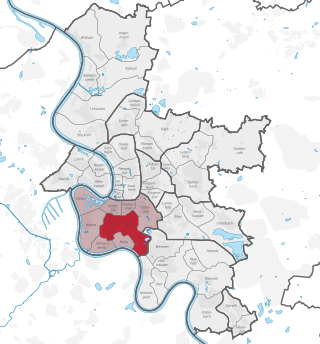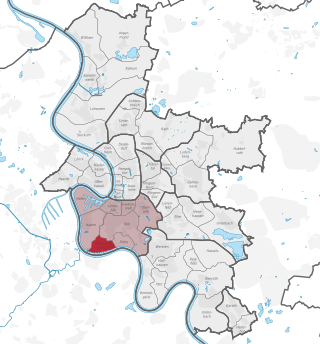
North Rhine-Westphalia or North-Rhine/Westphalia, commonly shortened to NRW, is a state (Land) in Western Germany. With more than 18 million inhabitants, it is the most populous state in Germany. Apart from the city-states, it is also the most densely populated state in Germany. Covering an area of 34,084 km2 (13,160 sq mi), it is the fourth-largest German state by size.

Duisburg is a city in the Ruhr metropolitan area of the western German state of North Rhine-Westphalia. Lying on the confluence of the Rhine and the Ruhr rivers in the center of the Rhine-Ruhr Region, Duisburg is the 5th largest city in North Rhine-Westphalia and the 15th-largest city in Germany.

Bergisch Gladbach is a city in the Cologne/Bonn Region of North Rhine-Westphalia, Germany, and capital of the Rheinisch-Bergischer Kreis (district).

Euskirchen is a town in North Rhine-Westphalia, Germany, capital of the district Euskirchen. While Euskirchen resembles a modern shopping town, it also has a history dating back over 700 years, having been granted town status in 1302. As of December 2007, it had a population of 55,446. Its local football club is called TSC Euskirchen.

Kaiserswerth is one of the oldest quarters of the City of Düsseldorf, part of Borough 5. It is in the north of the city and next to the river Rhine. It houses the Kaiserwerth Deaconesses' Institute where Florence Nightingale worked. Kaiserswerth has an area of 4.80 km2 (1.85 sq mi), and 7,923 inhabitants (2020).

Gerresheim is one of the City of Düsseldorf, Germany's fifty quarters. Part of Borough 7, it is located in the eastern part of the municipality. Gerresheim is much older than Düsseldorf itself, having been an independent city with a rich history for over 1,000 years. Gerresheim merged voluntarily with Düsseldorf in 1909.

Bilk is a quarter (Stadtteil) of Düsseldorf. Together with Oberbilk, Unterbilk, Hamm, Flehe and Volmerswerth it constitutes Borough 3, which is the most populous borough of Düsseldorf. Bilk has an area of 6.07 km2 (2.34 sq mi), and 41,150 inhabitants (2020). Heinrich-Heine-University is in Bilk.

The Altstadt is one of the 50 quarters of Düsseldorf, Germany; it belongs to central Borough 1. The Düsseldorfer Altstadt is known as "the longest bar in the world", because the small Old Town has more than 300 bars and discothèques; supposedly, each establishment's bar-counter connecting to one next door.

Golzheim is a quarter of Düsseldorf in Borough 1 on the Rhine, just north of the city center. It is primarily a business and hotel district, but retains some of the old stately villas.

Benrath is a quarter of Düsseldorf in the south of the city, part of Borough 9. It has been a part of Düsseldorf since 1929. Benrath has an area of 5.99 km2 (2.31 sq mi), and 17,178 inhabitants (2020).

Heerdt is one of the older quarters of the city of Düsseldorf, part of Borough 4. Heerdt and its neighbouring quarters Oberkassel, Niederkassel and Lörick lie on the left side of the river Rhine, opposite to the other districts of Düsseldorf and the central district. Heerdt has an area of 4.05 km2 (1.56 sq mi), and 12,395 inhabitants (2020).

Volmerswerth is a Stadtteil (quarter) in western Düsseldorf, Borough 3, by the river Rhine. It borders the quarters Hamm, Bilk and Flehe. It has an area of 2.22 km2 (0.86 sq mi), and 2,336 inhabitants (2020).
Dresden is a large city in the eastern Saxony nearby the border to the Czech Republic at the river Elbe. The geography and urban development of Dresden is embossed by the valley location and by the Elbe stream.

Düsseldorf-Hafen is an urban quarter of Düsseldorf, Germany, part of Borough 3, located on the river Rhine and the location of the city's docks.

Pempelfort is a city part in the North-east of the central Borough 1 of Düsseldorf.

Oberbilk is an inner-city urban quarter in the south-east of the German city of Düsseldorf. The back exit of the Central Station leads to Oberbilk. The new District Court of Düsseldorf is located in Oberbilk since 2010, as is the main office of the Communal Library of Düsseldorf. Oberbilk is also home to the Mitsubishi Electric Halle, a concert arena with a capacity for 7,500.

Unterbach is a quarter (Stadtteil) of Düsseldorf, part of Borough 8. Until a local reorganisation in 1975, it was a part of Erkrath, Germany. A portion of the pre-1975 Unterbach remains as the quarter of Erkrath-Unterfeldhaus. The eastern end of the borough of Düsseldorf-Vennhausen was attached to Unterbach during the reorganisation since it was already culturally associated with Unterbach.

Unterbilk is an urban quarter in Borough 3 of the North Rhine-Westphalia state capital Düsseldorf. It is the seat of the Landtag of North Rhine-Westphalia, the Rheinturm tower and, together with the Düsseldorf docks is the centre of the media industry in Düsseldorf.
Cologne is Germany's fourth-largest city and the largest city in the Rhineland. As of 31 December 2011, there were officially 1,017,155 residents. The city is center of the Cologne/Bonn Region with around 3 million inhabitants.

Borough 1 is the central borough of Düsseldorf, the state capital of North Rhine-Westphalia, Germany and the city's commercial and cultural center. The borough covers an area of 11.31 square kilometres and has about 86,000 inhabitants.








































